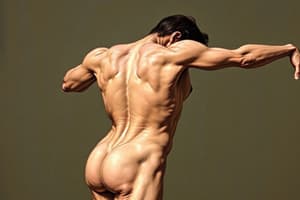Podcast
Questions and Answers
How do you perform the Multiplayer Lunge with Reach dynamic stretch?
How do you perform the Multiplayer Lunge with Reach dynamic stretch?
- Stand in proper alignment with hands on hips and feet straight ahead. 2. Draw navel inward. 3. Step forward and descend into a lunge position while reaching forward. 4. Use hip and thigh muscles to push up and back to the start position. 5. Perform 10 reps. 6. Repeat on opposite leg. 7. Progress to side lunges with reach, then turning lunges with reach.
How do you perform the Single-Leg Squat Touchdown dynamic stretch?
How do you perform the Single-Leg Squat Touchdown dynamic stretch?
- Stand on one leg in optimal posture. 2. Draw navel inward. 3. Squat by bending the ankle, knee, and hip while reaching the opposite hand near the standing leg toe. 4. Return to starting position. 5. Perform 10 reps. 6. Repeat on opposite side.
How do you perform the dynamic stretch Tube Walking: Side-to-Side?
How do you perform the dynamic stretch Tube Walking: Side-to-Side?
- Stand with feet hip-width apart, knees slightly bent. 2. Place tubing around lower leg. 3. Draw navel inward. 4. Take 10 small steps sideways without allowing knees to cave inward. 5. Repeat in the opposite direction.
How do you perform the dynamic stretch Medicine Ball Lift and Chop?
How do you perform the dynamic stretch Medicine Ball Lift and Chop?
Why is the inverted hurdler's stretch controversial?
Why is the inverted hurdler's stretch controversial?
Why is the Plow a controversial stretch?
Why is the Plow a controversial stretch?
Why is the shoulder stand a controversial stretch?
Why is the shoulder stand a controversial stretch?
Why is the straight-leg toe touch a controversial stretch?
Why is the straight-leg toe touch a controversial stretch?
What is controversial about the arching quadricep stretch?
What is controversial about the arching quadricep stretch?
What are probably overactive muscles when your feet turn out?
What are probably overactive muscles when your feet turn out?
What are probable underactive muscles when your feet turn out?
What are probable underactive muscles when your feet turn out?
What are two sample SMR techniques to use when your feet turn out?
What are two sample SMR techniques to use when your feet turn out?
What are two sample static stretches to use when your feet turn out?
What are two sample static stretches to use when your feet turn out?
What is a sample strengthening exercise to use when your feet turn out?
What is a sample strengthening exercise to use when your feet turn out?
What are probable overactive muscles when your knees move inward?
What are probable overactive muscles when your knees move inward?
What are probable underactive muscles when your knees move inward?
What are probable underactive muscles when your knees move inward?
What are two SMR techniques to use when knees move inward?
What are two SMR techniques to use when knees move inward?
What are two static stretches to do when your knees move inward?
What are two static stretches to do when your knees move inward?
What is a good strength exercise to do when your knees move inward?
What is a good strength exercise to do when your knees move inward?
If you have excessive forward lean, what muscles are probably overactive?
If you have excessive forward lean, what muscles are probably overactive?
If you have excessive forward lean, what muscles are probably under active?
If you have excessive forward lean, what muscles are probably under active?
If you have excessive forward lean, what are two SMR techniques you should use?
If you have excessive forward lean, what are two SMR techniques you should use?
If you have excessive forward lean, what are two static stretches you should use?
If you have excessive forward lean, what are two static stretches you should use?
If you have excessive forward lean, what strengthening exercise should you use?
If you have excessive forward lean, what strengthening exercise should you use?
If your low back arches, what muscles are probably overactive?
If your low back arches, what muscles are probably overactive?
If your low back arches, what muscles are probably under active?
If your low back arches, what muscles are probably under active?
If your low back arches, what two SMR techniques should you use?
If your low back arches, what two SMR techniques should you use?
If your low back arches, what two static stretches should you use?
If your low back arches, what two static stretches should you use?
If your low back arches, what strengthening exercise should you use?
If your low back arches, what strengthening exercise should you use?
If your arms fall forward, what muscles are probably overactive?
If your arms fall forward, what muscles are probably overactive?
If your arms fall forward, what muscles are probably under active?
If your arms fall forward, what muscles are probably under active?
If your arms fall forward, what two SMR techniques should you use?
If your arms fall forward, what two SMR techniques should you use?
If your arms fall forward, what two static stretches should you use?
If your arms fall forward, what two static stretches should you use?
If your arms fall forward, what strengthening exercise should you use?
If your arms fall forward, what strengthening exercise should you use?
If your shoulders elevate during the assessments, what muscles are probably overactive?
If your shoulders elevate during the assessments, what muscles are probably overactive?
If your shoulders elevate during the assessments, what muscles are probably under active?
If your shoulders elevate during the assessments, what muscles are probably under active?
If your shoulders elevate during the assessments, what SMR technique should you use?
If your shoulders elevate during the assessments, what SMR technique should you use?
If your shoulders elevate during the assessments, what static stretches should you do?
If your shoulders elevate during the assessments, what static stretches should you do?
If your shoulders elevate during the assessments, what strengthening exercise should you do?
If your shoulders elevate during the assessments, what strengthening exercise should you do?
If your head protrudes forward during the assessments, what muscles are probably overactive?
If your head protrudes forward during the assessments, what muscles are probably overactive?
If your head protrudes forward during the assessments, what muscles are probably under active?
If your head protrudes forward during the assessments, what muscles are probably under active?
If your head protrudes forward during the assessments, what SMR technique should you use?
If your head protrudes forward during the assessments, what SMR technique should you use?
Define flexibility.
Define flexibility.
Define extensibility.
Define extensibility.
Define dynamic range of motion.
Define dynamic range of motion.
Define neuromuscular efficiency.
Define neuromuscular efficiency.
Define postural distortion patterns.
Define postural distortion patterns.
Define relative flexibility.
Define relative flexibility.
Define muscle imbalance.
Define muscle imbalance.
Define reciprocal inhibition.
Define reciprocal inhibition.
Define altered reciprocal inhibition.
Define altered reciprocal inhibition.
Define synergistic dominance.
Define synergistic dominance.
Define arthrokinematics.
Define arthrokinematics.
Define arthrokinetic dysfunction.
Define arthrokinetic dysfunction.
Define autogenic inhibition.
Define autogenic inhibition.
Define pattern overload.
Define pattern overload.
Define static stretching.
Define static stretching.
Define dynamic stretching.
Define dynamic stretching.
What are the two mechanoreceptors located in muscle that help with neuromuscular efficiency?
What are the two mechanoreceptors located in muscle that help with neuromuscular efficiency?
When the GTO senses ______ it causes ______.
When the GTO senses ______ it causes ______.
When the muscle spindle senses ______ it causes ______.
When the muscle spindle senses ______ it causes ______.
Why do knots form in soft tissue?
Why do knots form in soft tissue?
Define Davis's law.
Define Davis's law.
Adhesions (contraction knots) form due to an inability to what?
Adhesions (contraction knots) form due to an inability to what?
What are the 3 phases of flexibility training within the OPT model?
What are the 3 phases of flexibility training within the OPT model?
What should you do for corrective flexibility?
What should you do for corrective flexibility?
What should you do for active flexibility?
What should you do for active flexibility?
What should you do for functional flexibility?
What should you do for functional flexibility?
Flexibility techniques should only be performed on what tissues?
Flexibility techniques should only be performed on what tissues?
Self-myofascial release is a stretching technique that focuses on what two systems in the body?
Self-myofascial release is a stretching technique that focuses on what two systems in the body?
When using SMR, you should find a tender spot and sustain pressure on that spot for a minimum of how long?
When using SMR, you should find a tender spot and sustain pressure on that spot for a minimum of how long?
Why should you use SMR before stretching?
Why should you use SMR before stretching?
How would you use SMR for the Gastrocnemius and Soleus?
How would you use SMR for the Gastrocnemius and Soleus?
How would you use SMR for your TFL/IT Band?
How would you use SMR for your TFL/IT Band?
How would you use SMR for your adductors?
How would you use SMR for your adductors?
How would you use SMR for the piriformis?
How would you use SMR for the piriformis?
How would you use SMR for the Latissimus Dorsi?
How would you use SMR for the Latissimus Dorsi?
What are the mechanisms of action of a static stretch?
What are the mechanisms of action of a static stretch?
What are the acute variables of a static stretch?
What are the acute variables of a static stretch?
How do you perform the static gastrocnemius stretch?
How do you perform the static gastrocnemius stretch?
How do you perform the Static Standing TFL Stretch?
How do you perform the Static Standing TFL Stretch?
How do you perform the Static Kneeling Hip Flexor Stretch?
How do you perform the Static Kneeling Hip Flexor Stretch?
How do you perform the Static Standing Adductor Stretch?
How do you perform the Static Standing Adductor Stretch?
How do you perform the Static Latissimus Dorsi Ball Stretch?
How do you perform the Static Latissimus Dorsi Ball Stretch?
How do you perform the Static Pectoral Stretch?
How do you perform the Static Pectoral Stretch?
How do you perform the Static Upper Trapezius/Scalene Stretch?
How do you perform the Static Upper Trapezius/Scalene Stretch?
What is the mechanism of action for the active-isolated stretch?
What is the mechanism of action for the active-isolated stretch?
What are the acute variables for the Active-Isolated Stretch?
What are the acute variables for the Active-Isolated Stretch?
How do you perform the Active Gastrocnemius Stretch with Pronation and Supination?
How do you perform the Active Gastrocnemius Stretch with Pronation and Supination?
How do you perform the Active Supine Biceps Femoris Stretch?
How do you perform the Active Supine Biceps Femoris Stretch?
How do you perform the Active Standing TFL Stretch?
How do you perform the Active Standing TFL Stretch?
How do you perform the Active Kneeling Hip Flexor Stretch?
How do you perform the Active Kneeling Hip Flexor Stretch?
How do you perform the Active Standing Adductor Stretch?
How do you perform the Active Standing Adductor Stretch?
How do you perform the Active Latissimus Dorsi Ball Stretch?
How do you perform the Active Latissimus Dorsi Ball Stretch?
How do you perform the Active Pectoral Stretch?
How do you perform the Active Pectoral Stretch?
How do you perform the Active Upper Trapezius/Scalene Stretch?
How do you perform the Active Upper Trapezius/Scalene Stretch?
What is the mechanism of action for the dynamic stretch?
What is the mechanism of action for the dynamic stretch?
What are the acute variables of the dynamic stretch?
What are the acute variables of the dynamic stretch?
How do you perform the prisoner squat for dynamic stretching?
How do you perform the prisoner squat for dynamic stretching?
Flashcards are hidden until you start studying
Study Notes
Flexibility and Related Concepts
- Flexibility: Normal extensibility of soft tissues for full joint motion.
- Extensibility: Ability to be elongated or stretched.
- Dynamic Range of Motion: Combination of flexibility and efficient nervous system control throughout a joint's full range.
- Neuromuscular Efficiency: System's capacity for agonists, antagonists, and stabilizers to work together across all movement planes.
- Postural Distortion Patterns: Predictable muscle imbalance patterns affecting posture and movement.
- Relative Flexibility: Body's tendency to follow the path of least resistance during movement.
Muscle Function and Interaction
- Muscle Imbalance: Alteration in muscle length around a joint affecting movement.
- Reciprocal Inhibition: Simultaneous contraction of one muscle and relaxation of its antagonist to facilitate movement.
- Altered Reciprocal Inhibition: Inhibition of functional antagonists due to tight agonists.
- Synergistic Dominance: When inappropriate muscles substitute for weak or inhibited prime movers.
Joint Motion and Dysfunction
- Arthrokinematics: Motion of joints in the body.
- Arthrokinetic Dysfunction: Abnormal joint forces leading to impaired muscular activity and communication.
Stretching Techniques
- Static Stretching: Holding a stretch at the point of tension for at least 30 seconds.
- Dynamic Stretching: Active extension using force and momentum to move joints through their full range.
Mechanisms and Effects of Stretching
- Static Stretch Mechanism: Involves autogenic or reciprocal inhibition based on stretch type.
- Active-Isolated Stretch Mechanism: Utilizes reciprocal inhibition for muscle elongation.
- Dynamic Stretch Mechanism: Also relies on reciprocal inhibition to facilitate movement.
Self-Myofascial Release (SMR)
- Purpose: Releases tension in overactive muscles, enhancing overall flexibility.
- Technique: Sustain pressure on tender spots for at least 30 seconds to relieve adhesions.
Flexibility Training Phases (OPT Model)
- Corrective Flexibility: Uses self-myofascial release and static stretching to address imbalances.
- Active Flexibility: Incorporates self-myofascial release and active-isolated stretching.
- Functional Flexibility: Involves self-myofascial release combined with dynamic stretching.
Flexibility Assessment and Application
- Perform flexibility techniques on tissues identified as overactive in assessments.
- Address muscle tension and spasm caused by trauma through SMR to prevent knots.
Practical Stretching Procedures
- Follow specific actions for the gastrocnemius, TFL/IT band, adductors, latissimus dorsi, and pectorals to ensure effective muscle elongation.
- Maintain core engagement and optimal posture during stretches to maximize benefits.
Acute Variables for Stretching
- Static Stretching: 1-3 sets, holding stretches for 30 seconds.
- Active-Isolated Stretching: 1-2 sets, 1-2 seconds hold for 5-10 repetitions.
- Dynamic Stretching: 1-2 sets, 10-15 repetitions covering various movement patterns.
Specialized Stretches
- Gastrocnemius Stretch: Keep the rear heel down while extending the back leg.
- Standing TFL Stretch: Requires gluteal contraction while achieving a mild stretch in the hip.
- Latissimus Dorsi Stretch: Focuses on maintaining controlled movement and core stability.
Key Points for Dynamic Stretching
- Emphasize full body alignment and controlled movements during exercises like prisoner squats and lunges.
- Incorporate variations targeting major muscles while ensuring safety and proper technique.### Medicine Ball Rotational Movement
- Stand with feet hip-width apart, knees slightly bent, and feet straight ahead.
- Grasp a medicine ball with both hands, keeping elbows fully extended.
- Engage core by drawing the belly button inward.
- Initiate trunk rotation, lifting the ball from a low to high position.
- Allow hips to pivot on the back foot as the motion completes.
- Perform 10 repetitions and repeat on the opposite side.
- The exercise enhances arthrokinematics in the lumbo-pelvic-hip complex.
Controversial Stretches
- Inverted Hurdler's Stretch: High stress on the inside of the knee, risking pain and kneecap stress.
- Plow Stretch: Head is lower than hips, causing stress on the neck and spine.
- Shoulder Stand: Similar to the Plow, places stress on the neck, shoulders, and spine.
- Straight-Leg Toe Touch: Can stress vertebrae and discs in the lower back; may lead to knee hyperextension.
- Arching Quadriceps Stretch: Puts significant stress on the kneecap and front knee tissues.
Muscle Activation Patterns
-
Feet Turn Out:
- Overactive: Soleus, Lateral Gastrocnemius, Biceps Femoris (short head).
- Underactive: Medial Gastrocnemius, Medial Hamstring Complex, Gracilis, Sartorius, Popliteus.
- SMR Techniques: Gastroc/Soleus, Biceps Femoris.
- Static Stretches: Gastroc Stretch, Supine Biceps Femoris Stretch.
- Strengthening Exercise: Single-Leg Balance Reach.
-
Knees Move Inward:
- Overactive: Adductor Complex, Biceps Femoris (short head), TFL, Vastus Lateralis.
- Underactive: Gluteus Medius/Maximus, Vastus Medialis Oblique (VMO).
- SMR Techniques: Adductors, TFL/IT Band.
- Static Stretches: Supine Biceps Femoris Stretch, Standing TFL Stretch.
- Strengthening Exercise: Tube Walking Side to Side.
-
Excessive Forward Lean:
- Overactive: Soleus, Gastrocnemius, Hip Flexor Complex (TFL, Rectus Femoris, Psoas), Abdominal Complex.
- Underactive: Anterior Tibialis, Gluteus Maximus, Erector Spinae.
- SMR Techniques: Gastroc/Soleus, Quadriceps.
- Static Stretches: Gastroc Stretch, Kneeling Hip Flexor Stretch.
- Strengthening Exercises: Quadruped Arm/Opposite Leg Raise, Ball Wall Squats.
-
Low Back Arches:
- Overactive: Hip Flexor Complex, Erector Spinae, Latissimus Dorsi.
- Underactive: Gluteus Maximus, Hamstring Complex, Intrinsic Core Stabilizers.
- SMR Techniques: Quadriceps, Latissimus Dorsi.
- Static Stretches: Kneeling Hip Flexor Stretch, Latissimus Dorsi Ball Stretch.
- Strengthening Exercises: Quadruped Arm/Opposite Leg Raise, Ball Wall Squats.
-
Arms Fall Forward:
- Overactive: Latissimus Dorsi, Teres Major, Pectoralis Major/Minor.
- Underactive: Mid/Lower Traps, Rhomboids, Rotator Cuff.
- SMR Techniques: Thoracic Spine, Latissimus Dorsi.
- Static Stretches: Latissimus Dorsi Ball Stretch, Pectoral Wall Stretch.
- Strengthening Exercise: Squat to Row.
-
Shoulders Elevate During Pushing/Pulling:
- Overactive: Upper Traps, Sternocleidomastoid, Levator Scapulae.
- Underactive: Mid/Lower Traps.
- SMR Technique: Upper Trapezius (Thera Cane).
- Static Stretches: Upper Trapezius/Scalene Stretch.
- Strengthening Exercise: Ball Cobra.
-
Head Protrudes Forward During Pushing/Pulling:
- Overactive: Upper Trapezius, Sternocleidomastoid, Levator Scapulae.
- Underactive: Deep Cervical Flexors.
- SMR Technique: Upper Trapezius (Thera Cane).
Studying That Suits You
Use AI to generate personalized quizzes and flashcards to suit your learning preferences.




